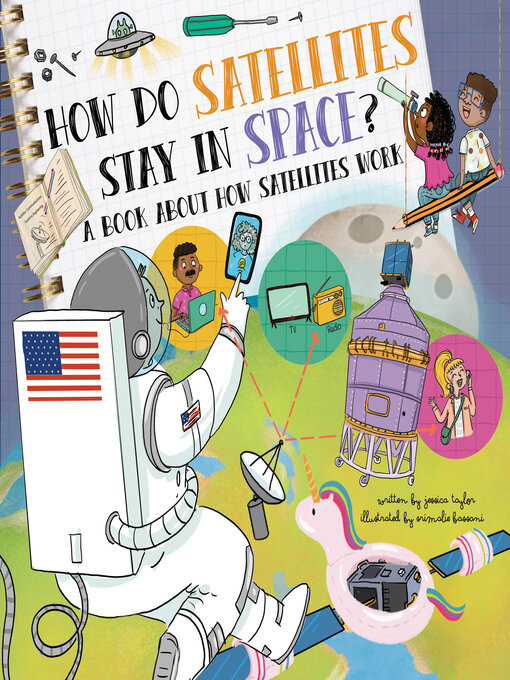Have you ever wondered how and why satellites go to space? A basic explanation of how satellites work, what information they collect, and what happens to them once they are in space is explored through diagrams, illustrations, and informative and engaging text in this newest addition to the How Do series.About the How Do series: These fully-illustrated nonfiction picture books are a great introduction to various STEM topics. Each title includes facts and figures, simple diagrams and hilarious illustrations and is written in a question-and-answer format to encourage readers to ask questions and guess the answers before exploring the science behind the correct answers.
How Do Satellites Stay in Space?
A Book About How Satellites Work
-
Creators
-
Series
-
Publisher
-
Release date
September 28, 2022 -
Formats
-
OverDrive Read
- ISBN: 9781486726646
-
-
Languages
- English
-
Reviews
-
Kirkus
July 1, 2022
An out-of-this-world exploration of how satellites work. Logically, the book begins with a definition of a satellite, and although there is a glossary, other important science words are clearly explained in context or with relatable comparisons, such as referring to a rocket with payloads as a bus with passengers. Taylor uses a question-and-answer format, and though some pages are packed with information, they're made more accessible by humorous text ("How do satellites get into space? Do scientists use a giant slingshot to launch them into the sky?") and playful cartoons that include speech-bubble comments by spacewalking astronauts, satellites, and a flamingo floatie in space and plenty of interesting diagrams and fun factoid inserts. The text concludes with a section on relevant STEM careers and photos of scientists at work. Variations in format and color--the deep blues of the sky and space are replaced with a more neutral palette for scenes set in a lab and at testing sites--make page turns a treat. Although humor also leads to unrealistic illustrations of workers repairing satellites in space without protective clothing and clean-room suits, also called bunny suits, shown with rabbit ears, this is a solid introduction to satellites. People depicted in both the photographs and the illustrations are racially diverse. (This book was reviewed digitally.) A friendly, enlightening text for future scientists or anyone curious about space. (Informational picture book. 7-10)COPYRIGHT(2022) Kirkus Reviews, ALL RIGHTS RESERVED.
-
Booklist
July 1, 2022
Grades 3-5 These new books in the How Do? series (2 new titles) take a light, playful approach to topics that involve serious science. The illustrations by Bassani have the feel of cartoons and often use speech bubbles to add somewhat silly commentary on the topics covered. In the text, questions introduce a new topic every couple of pages; often, a serious question is paired with a funny one. How Do Satellites Stay in Space? puts forth a more cohesive story, covering how satellites are launched, function, and are repaired in space, including questions like, "How do satellites avoid hitting other satellites or space junk in space? Do they wear inflatable floaties to protect them if they bump into one another?" Each set of questions is addressed in the next several pages of text. The back matter contains a comprehensive glossary and one or more extension activities for home use. A fun, slightly zany take on science topics that expands beyond the standard content.COPYRIGHT(2022) Booklist, ALL RIGHTS RESERVED.
-
School Library Journal
September 1, 2022
Gr 2-5-For young readers with lots of questions about satellites, this book has many of the answers. Taylor responds to an imaginary reader with thorough replies scaled to inform but not overwhelm or discourage. Bassani's illustrations are styled like a notebook and paper-collage pages. Detailed and fun, the artwork creates playful visuals to the questions Taylor poses. In response to "How do scientists fix satellites? Do they send space handy workers?" Bassani provides a literal interpretation of workers floating in space, fixing a satellite. The text explains why that scenario wouldn't work and how scientists do actually service satellites. This sort of engagement between the text and the artwork might encourage young readers to ask even more questions-even questions that seem silly! VERDICT In very few pages, author and illustrator collaborate to encourage children to pursue answers, no matter how trivial, and have fun while doing it. For larger collections.-Jessica Schriver
Copyright 2022 School Library Journal, LLC Used with permission.
-
Loading
Why is availability limited?
×Availability can change throughout the month based on the library's budget. You can still place a hold on the title, and your hold will be automatically filled as soon as the title is available again.
The Kindle Book format for this title is not supported on:
×Read-along ebook
×The OverDrive Read format of this ebook has professional narration that plays while you read in your browser. Learn more here.



